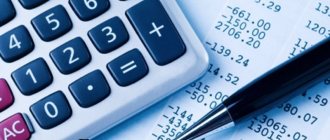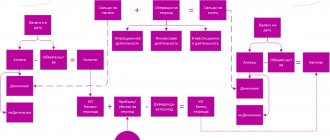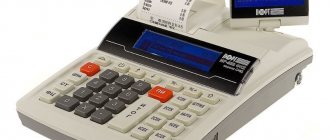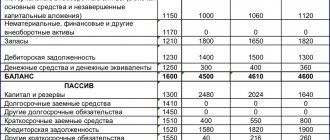Business lawyer > Accounting > Accounting and reporting > Line 2350 of the Financial Results Report: essence and rules for filling out
One of the most important indicators for assessing the performance of a business is its costs. They have a direct impact on the results of the work. In addition to production costs and commercial expenses, the Financial Results Report contains a separate line for expenses called “other”. The procedure for their calculation and inclusion in a financial document is regulated by accounting legislation.
General provisions about the Report
The financial results statement is one of the fundamental final accounting documents. Until 2013, it bore a name that reflected only the final indicator of business activity: profit or loss. Now it is clear from it that the content of the reporting document includes, in addition to the level of profit achieved or loss incurred, other indicators.
Financial statements
Based on the information presented in the final financial statements, an assessment is made of the financial and economic position of the company, the level of its profitability and liquidity, and operational stability. It is necessary to predict the future performance of a business, therefore it is used by almost all counterparties: government agencies, banking institutions, partners, investors.
The form for drawing up a financial report was approved by the Ministry of Finance by order No. 66 n of 2010 and is presented in the first appendix to it under the previously existing name “Profit and Loss Statement”. Information from this document supplements the information included in the main body of the company - the balance sheet.
If the balance sheet shows that a business entity has active funds and liabilities at the end of the reporting year, then from the report you can find out about the amount of income it has achieved over the past period of time and the expenses it has incurred in the course of business, the receipt of net profit or loss, i.e. about business performance over the past year.
Conventionally, the structure of the report under consideration is represented by four large sections:
- Company income and costs by main types of business activity.
- Amounts of income and expenses that differ from the main expenses and benefits - other.
- The financial result of doing business for the past annual period.
- Reference information.
The report is compiled for the entire enterprise, regardless of the tax regime used, under which it operates and whether it has independent structural divisions.
Annual data
In addition to the indicators of the reporting year, for example, for 2021, the document provides information for the same previous period, i.e. for 2021. As follows from the rule established by clause 10 of PBU 4/99, if the information for two adjacent years turns out to be incomparable, it must be brought to a comparable form by adjusting it.
PBU 9/99, dedicated to the profitability of companies, PBU 10/99, regulating expenses, classify all income and expenses of business entities into two groups:
- from normal (main) activities
- other
Each organization itself decides the issue of assigning certain costs to the first or second group, reflecting the accepted principles of separation in its internal accounting policy. This right is clarified by the Ministry of Finance in letter No. 07-02-06/203.
Where to find Form 2 Balance Sheet
Form 2 of the balance sheet is a table above which are given:
- reporting period and date;
- information about the organization (including codes OKPO, INN, OKVED, OKOPF, OKFS);
- unit of measurement (from 2021 - only thousand rubles).
The table with reporting indicators consists of 5 columns:
- number of the explanation to the report;
- name of the indicator;
- line code (it is taken from Appendix 4 to Order No. 66n);
- the value of the indicator for the reporting period and the same period of the previous year, which is transferred from the report for the previous year.
The indicators of the previous and reporting year must be comparable. This means that if the accounting rules change, last year’s ones should be transformed to the rules in force in the reporting year.
Read about how such a transformation is done in the material “Balance sheet of an enterprise for 3 years (nuances).”
What company costs are included in other expenses?
Expenses classified by the company as other are shown in the report under consideration on line 2350. Interest payable should be excluded from them.
Other costs include:
- costs incurred as a result of the company's participation in the charter of third-party business entities
- expenses caused by the write-off or sale of manufactured products, goods, fixed assets
- interest paid by an enterprise on credit and other similar obligations
- service costs in organizations lending business
- debt of counterparties with an expired statute of limitations
- expenses for issuing property for rent, including objects related to the company’s intellectual property
Expense items - allocations to reserve funds, which are formed in accordance with accounting rules (for depreciation of investments in the Central Bank, for problematic debt, etc.)
- allocations to own reserves, organized in cases of recognition of conditional facts of business affairs
- penalties, compensation, penalties, fines for violations of contractual discipline
- compensation for losses of other persons resulting from the actions of the company
- last year's losses recognized in the current period
- other debts that are not possible to collect
- difference in payment amounts or revenue resulting from changes in exchange rates
- markdown of owned resources
- donations to charity
- expenses for organizing cultural, entertainment, sports and other similar events
- expenses resulting from force majeure in business activities
Others – what are they?
The connection between costs and profits with the main or “other” activities of the organization can be traced based on data from the Unified State Register of Legal Entities extract. This document sets out the types of activities of the company indicated as the main ones during registration. If the costs or receipt of money are not related to the conduct of these particular types of activities, they should be classified as other when accounting.
Chart of accounts 9/99 “Income of the organization” regulates the assignment of finances to certain items. Chapter 3 “Other receipts” provides an open list of incoming funds for this purpose. Accountants usually consider these to include:
- funds received as a result of the sale of fixed assets;
- interest on loans provided to the organization;
- proceeds transferred free of charge;
- funds paid due to damage (for example, from insurers);
- losses from previous years;
- differences in exchange rates;
- irrecoverable accounts payable.
NOTE! The list is open - you can include in it other financial receipts that meet the “other” purpose. They must be provided for in the accounting policies of the organization. Examples of such income are surpluses discovered during inventory, remnants of usable materials or spare parts after disposal, etc.
If an enterprise is engaged in cargo transportation and simultaneously rents out a warehouse, rental income should be classified as other income. But if the main activity of the company is renting warehouses, then the profit from this will be the main and not other income.
Information on other expenses is contained in Chapter 3 of PBU 9/99 mentioned above. The listing of other expenses is also contained in an open list, which means that the accounting policy has the right to expand it. Most often, the following types of other expenses have to be included on the balance sheet:
- losses incurred during the sale of fixed assets;
- interest on loans received;
- costs associated with opening and maintaining a bank account;
- reserve fund for doubtful debts (every organization should have one);
- penalties, fines, monetary sanctions for violation of obligations to counterparties and tax authorities;
- losses of previous years recognized as such in the reporting period;
- receivables that have already expired;
- currency difference with a minus sign.
ATTENTION! The accounting policy has the right to justify the classification of other types of costs as “other”. For example, state duties and the amount of property tax are not directly indicated in the list of main expenses, they are not in the list of “other”, which means that the enterprise can independently determine the item of their accounting.
Other expenses include operating, non-operating and emergency expenses (clause 4 of PBU 10/99 “Expenses of the organization”). The list of operating expenses is established in paragraph 11 of PBU 10/99 “Expenses of the organization” (approved by order of the Ministry of Finance of Russia dated May 6, 1999 No. 33n), and the list of non-operating expenses is in paragraph 12.
In addition, tax accounting has adopted its own grouping of expenses. In accordance with paragraph 2 of Article 252 of the Tax Code of the Russian Federation, they are divided into expenses associated with production and sales, and non-operating expenses. Therefore, the same expenses of an organization are often reflected differently in its accounting and tax reporting. This is especially true for other expenses, the range of which is quite wide.
Information used to fill out line "2350"?
The information base for line 2350 of the financial document under consideration is the final turnover indicator. In this case, the following are not taken into account:
- accounts on which interest is payable
- value added tax invoices
- excise taxes
- other similar obligatory financial resources that the company receives from contractors and citizens
Data Search
The indicator for Dt 91-2 corresponds with the credit of various accounts: account. 01, count. 02, count. 10, count. 50, count. 52, count. 60, count. 62, count. 76.
In the financial report it is allowed not to make a detailed reflection of other expenses:
- If the accounting rules provide for or do not prohibit their reflection in this form.
- If the company’s income and the costs associated with them arose from one identical fact of entrepreneurial actions and are not particularly significant in the final parameter of the financial condition of the enterprise.
Profit (loss) before tax. Line 2300
This line reflects information about profit (loss) before tax (accounting profit (loss) of the organization) (clause
79 Regulations on accounting and financial reporting).
The value of this line is determined by adding the indicators of lines 2200 “Profit (loss) from sales”, 2310 “Income from participation in other organizations”, 2320 “Interest receivable” and 2340 “Other income” and subtracting the indicators of lines 2330 “Interest” from the resulting amount payable" and 2350 "Other expenses". If as a result the organization received a negative value (loss), then it is shown in the Statement of Financial Results in parentheses.
The value of line 2300 “Profit (loss) before tax” should be equal to the difference in the total debit and credit turnover in account 99 “Profit and loss” in correspondence with accounts 90 “Sales”, subaccount 90-9 “Profit/loss from sales”, and 91 “Other income and expenses”, subaccount 91-9 “Balance of other income and expenses”.
3.6.2. Report on financial results of small businesses. Filling procedure
Law and market 3.6.2.
Report on financial results of small businesses. Procedure for filling out by narodirossii • 12/23/2014 For reference: The profit and loss statement is called the Financial Results Statement... The profit and loss report is called the Financial Results Statement according to Part.
1 tbsp. 14 of Law N 402-FZ (on this issue, see also Information of the Ministry of Finance of Russia N PZ-10/2012 “On the entry into force on January 1, 2013 of the Federal Law of December 6, 2011 N 402-FZ “On Accounting” ). In this regard, this material uses the names – Statement of Financial Results and Explanations to the Balance Sheet and Statement of Financial Results.
The form of the Financial Results Report, which can be used by small business organizations, is approved by paragraph.
6.1 Order of the Ministry of Finance of Russia dated July 2, 2010 N 66n and is given in Appendix No. 5 to this Order.
Line 2350: examples of data entry
The indicator entered in line 2350 of the report under consideration is the sum of other company expenses without the total value of line 2330. For clarity, the formula for its calculation can be as follows:
Page 2350 = TO count. 91/2 – page 2330,
where DO count. 91/2 – the amount of annual turnover in the debit of subaccount 91-2.
Attention! When preparing a simplified reporting document, nothing is deducted from the total amount of the company's other expenses.
Let's look at a practical example of the calculation procedure and rules for filling out line 2350.
First option: the company shows the amounts in detail.
In this case, the volume of other expenses is simply equal to the final debit to subaccount 91-2:
Page 2350 = TO count. 91/2
This excludes excise taxes, VAT, interest payable and similar payments that the company receives from third-party business entities and citizens, reflected in account 91-2.
Second method: collapsed presentation of indicators.
Page 2350 = TO count. 91/2 for unbalanced other costs + (KO account 91/1 - DO 91/2) for balanced income and spent funds,
where KO count. 91/1 – total turnover according to Kt 91-1.
For example:
TO count. 91-2 equals 9870 thousand rubles.
KO account 91/1 is 7890 thousand rubles.
Then page 2350 = 9870 + (7890 – 9870) = 9870 – 1980 = 7890
The amount of costs related to other expenses of the organization is entered in parentheses (round brackets) in the document on the company's performance results. So, the result from the above example should be reflected in line 2350 in the following form: (7890).
So, in the course of business activities, in addition to the main costs, firms incur costs called other. Due to the fact that their number constitutes a significant share of the total expenses, the legislation distinguishes them into a separate group and requires them to be included in a special line of the annual financial report with code “2350”. The legislator provided business entities with freedom to classify their own expenses and consolidate it in their accounting policies.
Filling out line 2350 is based on the resulting accounting data, namely the final debit of subaccount 91-2 in correspondence with various accounts. The calculation of the amount depends on the option chosen by the company for reflecting the result: collapsed or expanded. The total value is indicated in the reporting document enclosed in parentheses.
Top
Write your question in the form below
Tax accounting of other income and expenses
In recognizing income and expenses as other for tax purposes, there are practically no discrepancies with accounting, except for some nuances that we will clarify below.
This operation is legally regulated by Art. 250 of the Tax Code of the Russian Federation “Non-operating income” (their list is closed, but more complete than the list of other income).
IMPORTANT! If the receipt is not mentioned in Art. 250 as non-realization, which means it belongs to the main ones.
In the tax accounting process, the amount of revenue rarely differs from that indicated in the balance sheet. But the appearance of such differences in some cases is still possible.
- The fixed asset that was sold was modernized, so the amount of depreciation varied by month.
- The fixed asset being sold had a different initial cost (for example, it was received by the organization under a leasing agreement).
- Positive differences in amounts not reflected in accounting.
The Tax Code of the Russian Federation defines all the subtleties of taxation associated with other expenses in Art. 265 “Non-operating expenses”. Just like income, their transfer is closed and does not allow expansion through other types of activities.
Some other income is not included in tax accounting, although it is mentioned as non-operating income. There are quite a lot of them, most often an accountant has to deal with the following.
- The company's expenses on various entertainment, cultural events, and charity.
- Budget contributions in the form of fines and penalties for tax payments.
- Interest accrued to the counterparty in excess of the limit under Articles 269 and 291 of the Tax Code of the Russian Federation.
IMPORTANT INFORMATION! Due to the difference in tax and accounting recognition of other expenses, permanent temporary differences are formed due to the application of PBU 18/02, the use of which is preferential for small businesses.
In accordance with the requirements of Chapter 25 of the Tax Code of the Russian Federation, expenses are divided into only two groups: expenses associated with production and sales, and non-operating expenses. Thus, in tax accounting there is no concept of operating expenses, and the term “non-operating expenses” has a different meaning than in accounting.
Table 1. Classification of operating expenses in tax accounting
| № | Operating expenses group | Classification in tax accounting |
| 1 | Costs associated with the provision of temporary use of the organization's assets for a fee | Non-operating expenses (subclause 1, clause 1, article 265), if they are incurred under no more than one lease agreement per year (subclause 2, clause 4 of the Methodological Recommendations for the Application of Chapter 25 of the Tax Code of the Russian Federation) |
| 2 | Costs associated with the provision for a fee of rights constituting the organization’s intellectual property | Non-operating expenses, if they are incurred under no more than one contract per year (subclause 1, clause 1, article 265) |
| 3 | Expenses associated with participation in the authorized capitals of other organizations | This activity is not related to sales (see, for example, clause 3 of Article 39 of the Tax Code of the Russian Federation), therefore, the expenses are non-operating (subclause 4 of clause 1 of Article 265 of the Tax Code of the Russian Federation - expenses associated with servicing purchased securities). The specifics of determining the tax base for such transactions are established by Art. 277 Tax Code of the Russian Federation |
| 4 | Expenses associated with the sale, disposal and other write-off of fixed assets and other assets other than cash (except currency), goods, products |
|
| 5 | Interest paid by an organization for providing it with funds (credits, loans) for use | Non-operating expenses (subclause 2 of clause 1 of Article 265 of the Tax Code of the Russian Federation) - within the limits established by Article 269 of the Tax Code of the Russian Federation, regardless of the purpose of loans and borrowings (including for the purchase of non-current assets and materials) |
| 6 | Expenses associated with payment for services provided by credit institutions |
|
| 7 | Deductions to valuation reserves (reserves for doubtful debts, for depreciation of investments in securities, etc.), as well as reserves created in connection with the recognition of contingent facts of economic activity |
|
| 8 | Other operating expenses - taxes | Other expenses associated with production and sales (subclause 1, clause 1, article 264 of the Tax Code of the Russian Federation) |
As can be seen from the above comparison of the requirements of accounting and tax legislation in relation to the group of expenses under consideration, there are significant methodological differences in them. Part of the operating expenses in tax accounting must be recognized as expenses related to production and sales and reflected on line 020 of sheet 2 of the income tax return with a breakdown in Appendix 2 (expenses in connection with the sale of assets - p.
140 and 150 adj. 2; taxes – page 070 adj. 2; part of the costs of banking services; expenses for leasing property and providing intellectual property for use, if this is not the subject of the organization’s activities, but occurred more than once during the reporting year). Let us note that if upon the sale of depreciable property, which in tax accounting includes fixed assets and intangible assets, the proceeds are less than the costs of sale, then for tax purposes the resulting loss is recognized in equal shares over the remaining life of the object (clause 3 of Art.
268 of the Tax Code of the Russian Federation), and not immediately, as in accounting. The other part of operating expenses in tax accounting is classified as non-operating expenses and is reflected on line 040 of sheet 2 of the income tax return with a breakdown in Appendix 7 (expenses for leasing property (line 070 appendix).
7) and provision of intellectual property for use, if this took place once during the reporting year; expenses in connection with the liquidation of fixed assets – page 080 adj. 7; the remaining cost of banking services; interest on borrowed funds within the norms - page 020 adj. 7; deductions to reserves for doubtful debts in the amount provided for by the Tax Code of the Russian Federation - page 030 adj. 7, etc.).
How to fill out an income statement
Copyright: photo bank Lori Statement of financial results (FIR) is a form included in any commercial company. This document and the principles of its preparation will be discussed in our publication.
Being a very significant reporting form, the FRF presents users with truthful results of work for the period under review, allowing them to develop the most promising business strategy or make other necessary economic decisions. A report is generated, like other forms of accounting, in particular, for the calendar year. Filling out the financial results report is carried out on the basis of the rules dictated by the regulatory documents governing its preparation - Regulations on accounting, approved.
by order of the Ministry of Finance of the Russian Federation dated July 29, 1998 No. 34n, law dated December 6, 2011 No. 402-FZ “On Accounting”.
3.2. Income statement. Filling procedure
Law and market by narodirossii • 12/17/2014 For reference: The profit and loss statement is called the Financial Results Statement... The profit and loss report is called the Financial Results Statement in accordance with Part 1 of Art. 14 of Law No. 402-FZ (on this issue, see
also Information of the Ministry of Finance of Russia N PZ-10/2012 “On entry into force on January 1, 2013.
Federal Law of December 6, 2011
N 402-FZ “On Accounting”).
In this regard, this material uses the names – Statement of Financial Results and Explanations to the Balance Sheet and Statement of Financial Results. The form of the Financial Results Report, approved by Order of the Ministry of Finance of Russia N 66n, is as follows. Explanations Name of indicator Code For _______ 20__
For ______ 20__ 1 2 3 4 5 Revenue 2110 Cost of sales 2120 ( )
Procedure for filling out the Financial Results Report
The form of the Financial Results Report was approved by order of the Russian Ministry of Finance dated July 2, 2010.
No. 66n. Name of report articles Line codes Accounts Note Revenue 2110 Total turnover on the credit of account 90 “Sales” subaccount “Revenue”; minus the turnover in the debit of account 90 of the subaccount: – “Value added tax”; – “Excise taxes” Revenue is income from ordinary activities, which include the sale of products and goods, performance of work, and provision of services. The list of such income is given in paragraph 5 of PBU 9/99 Cost of sales 2120 Total turnover in the debit of account 90 “Sales” subaccount “Cost of sales” in correspondence with the accounts: – 20 “Main production”; – 21 “Semi-finished products of own production”; – 23 “Auxiliary production”; – 29 “Service industries and farms”; – 40 “Release of products (works, services)”;
The procedure for filling out the Financial Results Report by a small enterprise
and other organizations that use simplified methods of accounting have the right to fill out the Statement of Financial Results in the form from Appendix No. 5 to the order of the Ministry of Finance of Russia dated July 2, 2010.
No. 66n (clause 6 of the order of the Ministry of Finance of Russia dated July 2, 2010
No. 66n). Machine-readable forms may also be used, although this is not required. Name of report articles Line codes Accounts Note Revenue 2110 Total turnover on the credit of account 90 “Sales” subaccount “Revenue”; minus the turnover in the debit of account 90 of the subaccount: – “Value added tax”; – “Excise taxes” Revenue is income from ordinary activities, which include the sale of products and goods, performance of work, provision of services.
We recommend reading: If the insurance company has accrued too little money for compulsory motor insurance, what to do
The list of such income is given in paragraph 5 of PBU 9/99 Expenses for ordinary activities 2120 Total turnover in the debit of account 90 “Sales” subaccount “Cost”
Other expenses.
Line 2350
This line reflects information about other expenses of the organization not mentioned above (clause.
21 PBU 10/99). What are other expenses of the organization?
With the exception of interest payable, other expenses include (clauses 11, 13 PBU 10/99, paragraph 2, clause 20, clause 22, paragraph 4, clause 38 PBU 19/02, clause
13, para. 3 clause 19 PBU 3/2006, clause
7 PBU 17/02, clause 25 PBU 5/01, clause
20 Guidelines for accounting of inventories, para.
6 clause 15 PBU 6/01, clause 21, 41 PBU 14/2007, clause 16 PBU 24/2011, clause 70 Regulations on accounting and financial reporting, Instructions for using the Chart of Accounts, clause.
14, para. 6 clause 9 PBU 22/2010): - expenses associated with the provision for a fee for temporary use (temporary possession and use) of the organization’s assets (if these expenses are not recognized by the organization as expenses for ordinary activities);
Financial results statement transcript of lines
In what form should a report on financial results be prepared? The form of the report on financial results (FR) is approved by the Ministry of Finance.
You can supplement it with lines that decipher the content of individual articles, but you cannot exclude articles from the report form (clause 3 of Order of the Ministry of Finance dated July 2, 2010 N 66n). General rules for filling out a statement of financial results The annual financial statement reflects data on income and expenses recognized in the company’s accounting records for the reporting and previous years.
You take last year's data from last year's report.
To fill out the lines with indicators for the reporting year, you will need: – a balance sheet for the subaccount “Other income” to account 91 “Other income and expenses” (with a breakdown by subaccount); – balance sheet for the subaccount “Other expenses” to account 91 “Other income and expenses” (with breakdown by subaccount). If the listed accounting registers do not contain data for filling out individual lines of the FRF, put a dash in these lines (clause
11 PBU 4/99)
How to fill out a statement of financial results line by line and their interpretation
Each company must not only organize its activities from the standpoint of increasing the efficiency of capital, material and labor resource management, but also evaluate the results for a certain period.
21 PBU 13/2000, clause 3, 7 PBU 15/2008, clause 15 PBU 2/2008, clause 14 PBU 20/03, clause
On the one hand, this is necessary in order to encourage employees who perform their duties well, and on the other hand, it allows us to identify problems that exist in the organization’s activities and find solutions.
One measurement method is the income statement (previously called the income statement). This document represents the main form of financial statements. It describes the financial results of the company for a certain period, which is called the reporting period.
The main information contained in it is the organization’s income and expenses, as well as the financial results themselves, which are reflected on an accrual basis.







